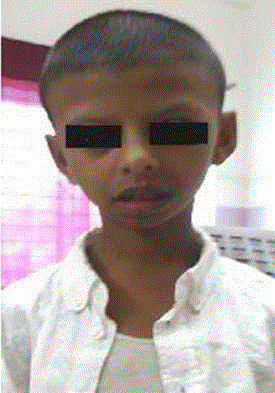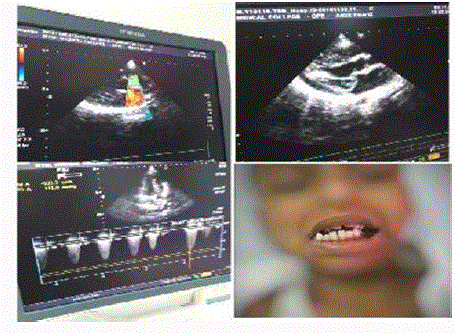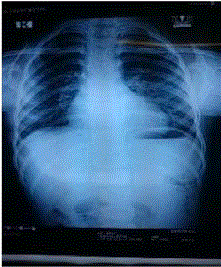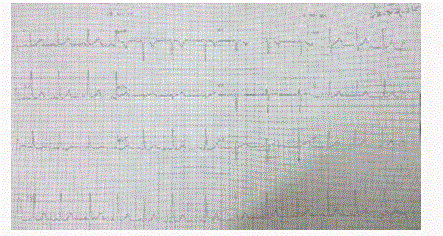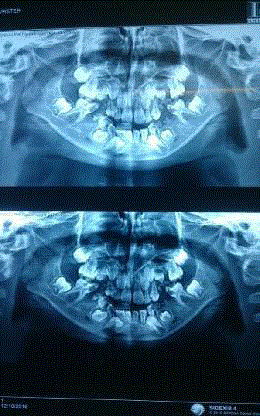Case Report
Facial Dysmorphism with Precordial Systolic Murmur of a Young Boy Williams Syndrome
Paul GK*, Bari MS, MMN Islam and Bari MA
Department of Cardiology, Mymensingh Medical College & Hospital, Bangladesh
*Corresponding author: Gobinda Kanti Paul, Department of Cardiology, Mymensingh Medical College & Hospital (MMC&H), Mymensingh, Bangladesh
Published: 30 Aug, 2017
Cite this article as: Paul GK, Bari MS, MMN Islam,
Bari MA. Facial Dysmorphism with
Precordial Systolic Murmur of a Young
Boy Williams Syndrome. Ann Clin Case
Rep. 2017; 2: 1427.
Abstract
A 7 years old boy diagnosed Williams’s syndrome by clinically with the help of some investigations. This child having mal-occlusion of multiple teeth with dental carries, large forehead, small chin, puffiness around both eye, looks like-elfin facies with low IQ. He has a systolic murmur (Grade-4/6) in the base of the heart. Echo, Doppler gradient found in the just supra-valvular area, 128 mmHg (Supra- valvular Aortic stenosis) and MVP (Mitra valve Prolapse). This child also having blockage of naso-lacrimal duct, causing watering of eye. William’s Syndrome (WS) is a neurodevelopmental, multisystem genetic disorder characterized by distinctive personality traits, facial dysmorphisom (elfin faceǁ) and congenital cardiac defects, of which supravalvular aortic stenosis is the most common lesion found. It is characterized by Congenital Heart Defects (CHD), Skeletal and renal anomalies, cognitive disorder, social personality disorder and dysmorphic facies. WS is a rare familial multisystem disorder occurring in 1 per 20,000 live births.
Introduction
William’s Syndrome (WS) is a rare but well recognized neurodevelopmental disease affecting the connective tissue and the central nervous system. It also affects cardiovascular system and eye. The syndrome was first described in 1961 by Newzealander JCP Williams [1,2]. It is caused by deletion of about 26 genes from the long arm of chromosome 7 and it occurs 1 in 7,500 to 1 in 20,000 live birth [3,4]. The underlying molecular mechanism is a submicroscopic chromosomal deletion involving the elastin gene (ELN) at 7q11.23 [5]. It is present at birth and affects boys and girls equally [3]. WS having infantile hypercalcamia, hoarseness of voice, hyperacusis, endocrine abnormalities, growth retardation, orthopedic problems and renal abnormalities may also be associated [6,7]. Due to variability in the clinical findings, diagnosis is usually made during midchildhood when the characteristics facial features, cognitive profile and cardiac findings become more apparent [8]. Beuren in 1964 independently described the syndrome noting also typical dental anomalies [9].
Case Presentation
A 7-years old boy diagnosed Williams Syndrome by clinically with the help of some investigations.
This boy actually referred from eye hospital for preoperative (Dacrocystorhinostomy/DCR
operation) cardiac consultation. The child was having large forehead, small chin, puffiness around
the both eyes, nose upturned, long philtrum looks like-elfin faciesǁ associated with malocclusion
of multiple teeth with Dental carries. He was of low IQ as he was in the same class for 3 years with
stunted growth, height 125 cm, weight 22 Kg. Precordial examination revealed systolic thrill and
systolic murmur (Grade-4/6) in the base of the heart.
His past history was not contributory except for few episodes of respiratory tract infections since
childhood. In the other family members, evidence of congenital anomaly or mental retardation was
not found. According to primary symptoms, clinical finding such as dysmorphic facies, cognitive
disorder and congenital supravalvular aortic stenosis, dental mal-occlusion and eye problem
(Lacrimal duct not patent), WS was the first diagnosis.
Chest X-ray revealed cardiomegaly, [10] leads ECG shows normal findings. Echocardiogram
showed normal chamber size, normal aortic valve leaflet but supravalvular aortic stenosis due to
narrowing of ascending aorta (PPG128mmHg) & prolapse of anterior mitral leaflet , other valvular
structure and pulmonary artery were normal. Other laboratory parameter, like Hb%, ESR, Serum
Calcium level was normal. We suggest a more attention for evaluating heart murmur in childhood
period, especially when the patient has abnormal facial features or mental problem (Figure 1-5).
Figure 1
Figure 2
Figure 3
Figure 4
Figure 5
Discussion
Williams’s syndrome is a rare familial multisystem disorder
occurring in 1 per 20,000 live births. It is characterized by congenital
heart defects (CHD), Skeletal and renal anomalies, cognitive disorder,
social personality disorder and dysmorphic facies. WS is characterized
by the triad, supravalvular aortic stenosis (AS), mental retardation and
elfin facies. In addition, mild microcephaly, neurologic dysfunction,
auditory hyperacusis, narrowing of the peripheral systemic and
pulmonary arteries, inguinal hernia, strabismus, epicanthic folds,
abnormalities of dental development, high prominent forehead
may be present [11]. In addition to typical facial features, patients
with WS have a characteristic ebullient personality profile that is
classically referred to as the cocktail personality. Patients with WS
are hypersocial and garrulous and have a relative verbal strength that
belies a mean IQ of 50 to 60 [12]. Patients 50% to 90% meet diagnostic criteria for anxiety disorder, attention deficit-hyperactivity disorder,
or phobic disorder [10]. Children with WS are overly social and
outgoing, inappropriately friendly to adults and unwary of strangers.
Hypercalcemia, which was a prominent features in the report of
Bongiovanni et al., [13] has been reported to occur in up to 50% of
patients with WS but this usually resolves without intervention in the
first two years [14]. WS babies typically have a low birth weight and
are often diagnosed as failing to thrive. Cardiovascular defects are the
most common cause of death in patients with WS [10]. Structural
cardiovascular abnormalities occur in about 80% of all WS patients
and are present in up to 93% of WS patients presenting in the first
year of life [15]. Although a number of cardiovascular abnormalities
are common to WS, the majority consist of some form arterial
stenosis. Three anatomical types of supravalvular AS are recognized.
The most common is the hourglass type, in which marked thickening
and disorganization of the aortic media produce a constricting annular
ridge at the superior margin of the sinuses of Valsalva. Uniform
hypoplasia of the ascending aorta characterizes the hypoplastic type.
Genetic studies suggest that the familial anomaly is transmitted as
an autosomal dominant trait with variable expression. The typical
appearance is similar to the elfin facies observed in the severe form of
idiopathic infantile hypercalcemia [10].
Williams Syndrome is a rare genetic disorder-so rare, in fact,
that few people have ever heard of it. Special care needs to be taken
when children with WS are given anesthesia. Little babies will come
up to you, they will stare into your face and it will be hard to actually
disengage from that stare explained Helen Tager-Flusberg whose lab at Boston University studies the social behavior of children
with WS. Genetic diagnosis is confirmed by micro-array analysis
& also by the Fluorescent in Situ Hybridization (FISH) test. Multispecialty
approach is needed. WS cannot be cured, but the ensuing
symptoms, developmental delays, learning problems & behaviors can
be treated. Correction of cardiac defects, cognitive behavior therapy,
avoidance of extra Calcium & Vitamin D these are the treatment
options.
Conclusion
We present a particular case of Williams Syndrome with low
IQ, congenital supravalvular aortic stenosis, stunted growth, eye
problems, defective dental enamel and mal-occlusion of multiple
teeth. More than 99% of individuals with the clinical diagnosis of WS
have this contigous gene delation, detected by FISH.
We should keep in mind and give more attention for evaluating
heart murmur in childhood, especially when the patient has abnormal
facial dysmorphisom or mental retardation.
References
- Beuren AJ. Supravalvular aortic stenosis: a complex syndrome with and without mental retardation. Birth Defects Orig Art Ser. 1972; 8: 45-56.
- Williams JC, Barratt-Boyes BG, Lowes JB. Supravalvular aortic stenosis. Circulation. 1961; 24: 1311-1318.
- Morris CA, Demsey SA, Leonard CO, Dilts C, Blackburn BL. Natural history of Williams syndrome: physical characteristics. J Pediatr. 1988; 113: 318-326.
- Stromme P, Bjornstad PG, Ramstad K. Prevalence estimation of Williams’s syndrome. J Child Neurol. 2002; 17: 269-271.
- Ewart AK, Morris CA, Atkinson D, Jin W, Sterners K, Spallone P, et al. Hemizygosity at the elastin locus in a developmental disorder, Williams syndrome. Nat Genet. 1993; 5: 11-16.
- Gothelf D, Farber N, Raveh E, Apter A, Attias J. Hyperacusis in Williams syndrome: Characteristics and associated neuroaudiologic abnormalities. Neurol. 2006; 66: 390-395.
- Boscherini B, Cappa M, Colabucci F, Galasso C, Giannotti A, Pasquino AM. Growth and pubertal spurt in Williams syndrome. Acta Med Auxol. 1993; 25: 185-189.
- Lashkari A, Smith AK, Graham JM. Williams-Beuren syndrome: an update and review for the primary physician. Clin Pediatr. 1999; 38: 189-208.
- Beuren AJ. A new syndrome: supravalvular aortic stenosis, multiple peripheral pulmonary stenosis, mental retardation, similar facial features and identical dental abnormalities. Monatsschrift fur kinderheilkunde. 1964; 112: 218-221.
- Pober BR. Williams-Beuren syndrome. N Engl J Med. 2010; 362: 239-252.
- Kwang kon koh, Jin Ho Lee, Dae Won Sohn, Byung Hee Oh, Young Bae Park, Yun Shik Choi, et al. Infective Endocarditis in a Patient with Williams Syndrome. Case Report. The Korean J Int Med. 1988; 3: 142-147.
- Martens MA, Wilson SJ, Reutens DC. Research Review: Williams’s syndrome: a critical review of the cognitive, behavioral and neuroanatomical phenotype. J Child Psychol Psychiatry. 2008; 49: 576-608.
- Bongiovanni AM, Eberlein WR, Jones IT. Idiopathic hypercalcemia of infancy, with failure to thrive; report of three cases, with a consideration of the possible etiology. N Engl J Med. 1957; 257: 951-958.
- Wang MS, Schinzel A, Kotzot D, Balmer D, Casey R, Chodirker BN, et al. Molecular factors in the deletion region or imprinting affecting clinical outcome. Am J Med Genet. 1999; 86: 34-43.
- Collins RT, Kaplan P, Somes GW, Rome JJ. Cardiovascular abnormalities, interventions and long-term outcomes in infantile Williams’s syndrome. J Pediatr. 2010; 156: 253-258.

